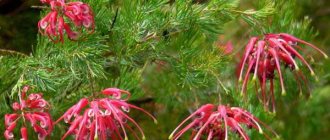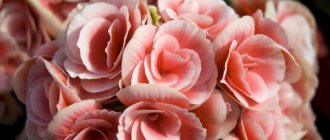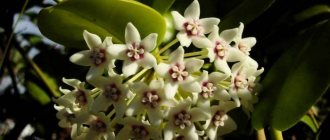Some novice flower growers believe that only specialists can grow a beautiful Phalaenopsis orchid in a pot at home. There is no need to be mistaken. If you read our article “Phalaenopsis - care in a pot at home”, you will see how unpretentious this plant is that it will not be difficult for you to cope with its cultivation. Then you will definitely have a question - how to get at least one more such unusually beautiful, constantly blooming bush? We will answer it in this article and tell you about the nuances of propagating the Phalaenopsis orchid at home.
Comparison of outdoor and indoor plants
When growing a plant outside, it will reproduce in two ways, but indoor flowers have many more of them.
In nature, phalaenopsis reproduce quite interestingly - with the wind, the pollen located in the seed capsules is carried and deposited in different places. In addition, the flower emits an amazing aroma, which attracts various insects. Once the seeds of a plant have fallen to the ground, they cannot just germinate; they need soil fungi to receive carbohydrates from them for germination and development. The next way to propagate phalaenopsis in nature is to form new layerings and shoots after flowering . Both methods: seeds and shoots work great. But propagating a home flower by seeds is quite problematic and it is not always possible to get a healthy plant.
Reproduction of phalaenopsis by seeds
This method is quite labor-intensive. Pollination of a flower does not cause problems for anyone. The fruits ripen for about 3–6 months – that’s when the main difficulties appear. After all, you cannot sow an orchid, like, for example, lettuce or radishes. Its seeds are so small that they resemble dust. They are deprived of nutrients, and the embryo is greatly reduced. Therefore, such seeds need to be sown on an agar-based nutrient medium. It is necessary to create absolute sterility so that subsequently there is no contamination of the environment and seeds, which will lead to their death. You will have to be patient, because their germination is a long process, and even if you successfully obtain small plants, you will have to wait for more than one year for the first flowering.
Growing methods and their description
Phalaenopsis reproduces in the following ways:
- By cuttings . For this method, a flower arrow is used, which is cut into cuttings with dormant buds. They are then rooted to create new plants.
- Bush division . The essence of this method is to divide the mother plant into 2 parts. The upper part is cut off and rooted separately, while the lower part continues to grow on its roots and dormant buds awaken in the axils of its leaves.
- Children . This method involves using awakened buds that form and form small orchids. They need to be separated from the parent plant and planted in separate containers.
- Seeds . This method requires creating sterile conditions, but then a plant can grow whose flowers will differ from the parent orchid in color and shape.
Separation of orchid babies from a peduncle
After flowering and removal of faded flowers, the 2-year-old peduncle is cut with a sterile knife and placed in a container of water (its temperature should not be lower than room temperature), like cut flowers. You can add a little liquid mineral fertilizer for orchids to the water, but this is not a prerequisite. Tall and narrow transparent containers with a lid or a plastic bottle with the neck cut off work best. Over time, babies will begin to appear on the flower stalks. As soon as the small plants grow up, they are separated with part of the peduncle and planted, first secured with staples on the ground. The whole procedure is repeated, as in the case of children who grew up on a peduncle that was not separated from an adult plant.
Does the plant need to be stimulated?
Sometimes orchids are able to produce babies without intervention. In this case, you just need to watch them until they form 2 pairs of young leaves. After this, aerial roots are formed, and when their length reaches 5 cm, they can be carefully separated.
If this process does not occur, then you need to stimulate the plant, following the following action plan:
Remove the scales as carefully as possible so as not to injure the dormant buds.- Apply a small amount of cytokinin ointment to them.
Hormonal paste can be purchased at the store or prepared at home using the following ingredients:
- kinetin – 10 mg;
- water – 1 ml;
- lanolin – 1 g.
All ingredients must be mixed thoroughly until the mixture becomes homogeneous and its color is white.
Quite often, only one side shoot is formed during propagation . To prevent this, you need to place the flower in a greenhouse where the temperature is not lower than 28 degrees Celsius. The plant should be in the greenhouse for 5 days, and after that it can be treated with paste.
We invite you to watch a video about the use of cytokinin ointment on orchids:
Proper care of an orchid
The orchid needs to be provided with a little rest; for this, it is placed in a separate place from all plants so as to avoid direct rays of the sun. At this time, the flower is not fed or watered, but simply monitored so that various pests do not appear. The flower is left in this state for two weeks, and then the flower is gradually accustomed to watering and lighting.
Proper lighting is also necessary; it must be enough, otherwise the leaves will become light and then turn yellow. The orchid must be positioned so that it receives a lot of diffused light, without direct rays of the sun. In summer, the bush is darkened a little; a matte film is used for this. Since there is not much sunlight in autumn, the film can be removed; during this period the plant goes into a dormant state. In winter, daylight hours should be about 12 hours, otherwise additional lighting with lamps is used.
Recommendations
How to determine that a flower is ready to reproduce?
Phalaenopsis can only be propagated using an adult plant. It should form 5 healthy leaves, develop a root system, and the flower should be at least 3 years old.
Preparing an orchid for reproduction lasts about 2 weeks. Its essence is as follows:
- Place the plant in a place well lit by sunlight, but it should be diffused and not direct.
- Stop watering for this time, arrange a temperature difference so that it is 28 degrees during the day and 15-16 degrees at night.
- Carefully observe the root system; if it has turned silver instead of green, then wait another 2-3 days; water only when the flower is ready to reproduce.
Cytokinin paste: what is it and how to use it
Cytokinin paste is a phytohormonal preparation that helps, among other things, stimulate the formation of growth buds in orchids. It stimulates cell division at the site of application. The product can only be used if there is a peduncle on the plant. Experienced orchid lovers are advised to apply the drug to the highest or lowest “dormant” bud. The best time for the procedure is the end of February or March.
Cytokinin paste is a unique phytohormone that allows you to achieve significant success in the propagation of orchids
- Using a sterile razor blade, scalpel, or needle, remove the integumentary scale from it. Remove loose tissue with tweezers. There should be a small light green dot underneath them.
- Very carefully and shallowly scratch it 2-3 times with a clean needle.
- Place cytokinin paste on a toothpick (a ball with a diameter of about 2.5 mm is enough). If possible, distribute the drug evenly over the kidney, lubricating it entirely. It is important to comply with the norm. If there was not enough paste (a ball with a diameter of 1.5–2 mm), a peduncle will most likely form. If you overdo it, several deformed, non-viable “babies” will develop.
- In a week or a week and a half, it should hatch and begin to develop. Place the phalaenopsis with the developing “offsprings” in a warm and bright place, apply fertilizer regularly. At this time, the orchid needs more nitrogen than usual.
The process of using cytokinin paste looks like this:
Cytokinin paste is used very sparingly (maximum three buds are “awakened” on the orchid at the same time) and targeted (the drug should not come into contact with leaves, flowers, or roots). The plant must be mature (young ones may lose leaves).
If done correctly, cytokinin paste guarantees a 100% positive result
Video: using cytokinin paste for orchid propagation
How to propagate an orchid?
Cuttings
The method of propagating orchids by cuttings is the simplest and does not require much time and attention. It is carried out as follows:
- It is necessary to cut off a side shoot from the mother plant; its length should be within 10-15 cm.
- Place the planting material on a moistened soil surface and cover it with a plastic bag, building a small greenhouse.
- Wet sand or sphagnum is suitable as soil.
- When cutting cuttings, it is important that each has 2 nodes with axillary buds. In addition, the lower buds of the peduncle are the strongest.
Seeds
Propagation of orchids by seeds at home is used extremely rarely, since this method is very complicated. For these purposes, it will be necessary to create an artificial nutrient medium. It is in it that the planting material will remain until germination. This may take 3-9 months. But it is difficult to maintain complete sterility here, since it is simply impossible to get rid of mold fungi.
When the seeds germinate, they must be kept under certain conditions for 3 years, and only then planted in a permanent place. You can expect phalaenopsis to bloom in 2 years.
Children
This method of orchid propagation is the most optimal. Its essence is that plant children grow from dormant buds . They are formed on the peduncle and on the stem of the plant. Sometimes this happens on its own, but most often it is necessary to carry out stimulation artificially.
You can do this in several ways:
- division of the mother plant;
- drying of the earthen coma and temperature changes;
- use of a hormonal stimulant;
- division of the peduncle.
An adult orchid can be divided if it is completely healthy . It must have powerful aerial roots and at least 7 leaves.
The procedure is as follows:
Using a sharp knife, cut off the top.- Treat the cut area with activated carbon powder.
- Divide so that the lower part of the flower has aerial roots (at least 3-4) and several leaves (3-4).
- Transplant the cut part into another container for rooting. On the lower part, after some time, babies form from the sinuses.
- As soon as the length of the root system is 5-6 cm, the plants can be removed and planted.
We invite you to watch a video about separating a baby from an orchid:
By division
The division method is simple, but it is suitable for adult phalaenopsis . To do this, several conditions must be met:
a powerful rosette containing at least 6 leaves;- aerial roots (2-3), which should be well developed.
Procedure:
- Using a sharp knife, cut off the top of the plant so that there are 3-4 leaves and aerial roots.
- Treat the cut areas with activated carbon powder and plant the cuttings in the prepared substrate.
- The lower part of the mother bush should be in its own pot.
- You can also plant aerial roots in a separate container, but their length should be more than 5 cm.
We invite you to watch a video on how to propagate an orchid by division:
Peduncle
This is another simple method that is carried out according to the following plan:
- When flowering ends, remove the peduncle at the very base.
- Immediately divide it into several parts of 3-4 cm.
You need to make sure that each part has one dormant bud, and it should be located in the middle of the cutting. - The cut must be treated with crushed coal.
- Place the cuttings in moistened sphagnum moss and build a mini-greenhouse.
- At a temperature of 25-28 degrees, the cuttings will produce roots, only the air under the film must be moist.
Roots
Even a beginner can do this method of reproduction:
- Lift the plant above the pot and carefully remove it from the soil.
- Cut the rhizome with a sterile knife, leaving 2-3 pseudobulbs and a sprout.
- Sprinkle the cut area with crushed coal.
- Transplant each division into a separate pot with fresh soil. Spray it 2 times a day until real leaves and good roots appear.
Possible mistakes when propagating orchids
Reproduction of phalaenopsis is a complex process. It will be unsuccessful if mistakes are made during its implementation. The main mistakes that inexperienced gardeners make:
- The introduction of infection when cutting cuttings and separating children entails rotting of the cuttings, children and the mother plant. To prevent this from happening, it is necessary to thoroughly disinfect all cutting tools. The sections are treated with powdered activated carbon;
- Incorrect separation of children. It is necessary to separate the children from the mother plant very carefully. Otherwise, there is a high risk of damage to the baby and the mother plant, which entails their death. It is also necessary to carefully separate the children from the peduncles before planting, otherwise the rotting of the remains of the peduncle leads to the rotting of the children;
- Incorrect or insufficient care of young plants. Young phalaenopsis require careful care. They are critical to air humidity, watering, temperature and lighting. Baby orchids are not as resistant to external conditions as adult plants. If not properly cared for, they quickly die.
Photo
Below are step-by-step photos showing how a home orchid propagates.
Preparatory work
It is advisable to plant phalaenopsis in special containers intended for orchids. These are transparent plastic pots with drainage holes and holes on the sides for better air circulation and illumination of the root system.
Since during propagation the root system of the children is still small, you can use not large containers, but small transparent plastic cups with holes made.
The soil is also important. Orchids are epiphytes and in the wild grow on trees directly from the bark. When growing at home, it is desirable to bring the conditions closer to natural ones, so the substrate should consist mainly of tree bark, most often pine.
Sphagnum moss, brick chips, and foam are also added to it. Before planting, the bark must be treated by boiling in water for 20 minutes.
Did you know? Phalaenopsis is mentioned in literary works. Thus, in the series of books by Rex Stout about detective Nero Wolfe, the main character is a passionate collector of orchids, among which phalaenopsis occupy a special place.
Before propagation, you need to inspect the flower itself. It must be healthy, without any spots, blackening or withering on the stem.
How to care?
Humidity
For phalaenopsis, a humidity of 50-80% is considered ideal . A humidity of 25-85% is possible, but then the development of diseases, especially fungal ones, cannot be ruled out.
Temperature
A temperature of 28-30 degrees is ideal for flower propagation.
Indicators may rise above the norm, but not below.
The soil
You can prepare the nutrient substrate yourself using small pieces of pine bark - 0.5-1 cm, and also take the same amount of soil from the mother pot.
Watering
Watering phalaenopsis must be done regularly, avoiding standing water and drying out. To moisten the soil, use settled and warm water. Pour it strictly at the root.
Reproduction of phalaenopsis is a responsible process that requires special attention and labor. When choosing the appropriate method, several points need to be taken into account, but novice gardeners are better off resorting to propagation by peduncles or dividing the bush. And in order for the plant to please with its active growth and beautiful flowering, you need to create adequate conditions and regularly care for it.
How to plant Phalaenopsis at home?
Basic Rules
For your intention to be crowned with success, it is necessary to provide the orchid with proper care long before attempting to plant it.
An important aspect in the development of exotic plants is the temperature regime - for the comfortable existence of the plant, a constant temperature in the range of 16 - 32 C is necessary . To stimulate flowering, the temperature is reduced to 13-16 C for several weeks.
As for air humidity, ideally it should be in the range of 50-80% . Low air humidity, spraying, and the presence of drafts negatively affect the flowering of Phalaenopsis.
Practical advice
- To determine the most comfortable habitat for a plant in an apartment, experiment! If the apartment has 3-4 windows, try leaving a flower pot on each of the window sills one by one, while paying attention to the change in the orchid’s condition. The plant's permanent habitat will depend on where it blooms most quickly;
- If you still have little experience in growing orchids, then try to keep a diary . Write down any little things you noticed during the experiments there, this will help you avoid mistakes in breeding Phalaenopsis in the future;
- To stimulate orchid reproduction, organize a “drought” . To do this, water the plants no more than once every 2 weeks. The frequency of water procedures is determined by the color of the root system; if handled correctly, it should change from bright green after watering to light gray. The silvery tint of the roots indicates that after a few days it is necessary to saturate the plant with water. There is a very important point: during poor watering, Phalaenopsis must be protected from direct sunlight , otherwise the exotic plant may be seriously damaged;
Possible growing problems
When growing a flower, some problems may arise.
They are mainly associated with improper care:
- Fungal diseases. The appearance and spread of fungal rot most often occurs with abundant watering. The affected parts must be removed. For treatment, use a fungicide, for example, Mikosan.
- Yellow spots on the leaves . This could be a sign of sunburn. The plant needs to be moved to a less lit place. It is better to avoid placing it on a southern windowsill.
- Dropping leaves. The cause is most likely a draft or too cold air. There may also be a violation of the general rules of temperature, humidity, watering and fertilizers. In order to avoid such problems, you need to follow the instructions for caring for phalaenopsis as strictly as possible.
Reproduction of phalaenopsis is not the easiest and rather painstaking work. However, if all the rules are followed, the planted daughter orchid will definitely grow and will delight the owner with beautiful flowering.
Stimulation of phalaenopsis buds by drought and temperature changes
Necessary conditions for stimulating the reproduction of phalaenopsis at home:
- The time for stimulation is spring.
- Phalaenopsis should be exposed to sunlight for at least 4 hours a day. Therefore, all windows are suitable for it, except for the northern and northwestern ones.
- The plant must be healthy, mature (over 3 years old), rested after the last flowering, with a good root system, with at least 4 leaves.
- The phalaenopsis peduncle should be no older than 1.5 years and cut to the top bud.
We affect phalaenopsis with drought and temperature changes. That is, during stimulation, watering should be very sparse, or not watered at all for 10-15 days.
The temperature at this time should be as follows: night +16-18°C, daytime +25-30°C.
Phalaenopsis babies
The daytime temperature must be high in order for the baby, and not the flowers, to emerge from the bud. If during the day it is below +25°C, then a side branch with buds may grow from the bud.
By the way, this circumstance can be taken into account by those who want to get their phalaenopsis to bloom again.
How to care for phalaenopsis babies?
The watering issue is easily resolved. How to achieve such a “warm-cool” mode?
If you start stimulation in March, then considering that at this time of year it is still cold on the windowsill at night, and the good sun is already warming up during the day, you can achieve a significant temperature difference. All you have to do is reduce, or better yet stop, watering for two weeks.
There have been cases when, when placing an orchid on a windowsill, its peduncle was located directly above the central heating radiator. And after some time he gave the baby.
This suggests that warm conditions promote the birth of babies. And don't forget about humidity. It is better if there is a vessel with water on the battery or next to it.
If you start stimulation at the end of April - beginning of May, then at this time the phalaenopsis can already be taken out onto the glassed-in balcony. Just keep an eye on the weather forecast; if it’s frosty, bring the orchid into the room. The most important thing is that the peduncle warms up well in the sun, and the leaves can be shaded so that they do not get burned.
How to properly plant an orchid in a pot
As a rule, with prolonged drying of the soil and good warming of the dormant buds, after 1-2 weeks they swell, and after another week the first leaf appears.
How to separate a baby phalaenopsis? After the appearance of aerial roots 10-15 cm long, the young plant with part of the peduncle is separated with a sharp and sterile instrument.
The sections are treated with cinnamon or charcoal, after which the baby is planted in soil for orchids, which is covered with sphagnum moss on top. The plant requires moisture and warm conditions for rooting.
Features of this method of reproduction
It should be taken into account that the division in any case will be incomplete, since young pseudobulbs may be located on one of the parts. And they, as a rule, take root much better and faster. The second part may have mostly old pseudobulbs. They take root very slowly. This phenomenon can be explained by the fact that the young pseudobulb contains a fully developed bud, from which a viable and young shoot will soon grow. The old pseudobulb does not have this bud. A peduncle may form on it. This is achieved due to small buds that remain at rest. The increase in this case will be insignificant.
If the orchid is large, then you should prepare in advance for dividing its rhizomes. About a year before full division, in those places where the cutting will take place, cuts need to be made to the middle of the rhizome. Such actions stimulate the growth and development of accessory buds. Thanks to this, by the time the root is divided and transplanted, a sufficient number of divisions will be obtained.
Why doesn't phalaenopsis bloom?
3 months after the end of flowering, the orchid should bloom again. But sometimes phalaenopsis begins to actively grow, to the detriment of flowering. Here are the main reasons why the bush does not bloom again:
- This is overfertilization with nitrogen. In this case, it takes time for the phalaenopsis to process all the nitrogen in the soil. For such a period, the orchid must be fertilized only with phosphorus fertilizers;
- This is a lack of lighting. Move the phalaenopsis to a more illuminated place or provide additional lighting;
- This is the exhaustion of the orchid. In this case, only time will help the plant and only then can flowering be stimulated.
Phalaenopsis philippinensis. ©Orchi
Use of children
Reviews of orchid propagation methods often say that separating its children is the most effective way. Their formation occurs on the trunks of peduncles, next to the blossoming buds.
Propagation of orchids by children is carried out by cutting off a new rosette and transplanting it into pre-prepared soil, which is sold in gardening stores and is intended specifically for planting orchids. The process of separating the baby should be done only when it produces small roots.
Many beginning gardeners sometimes have questions related to the absence of children for several years. As practice shows, their appearance occurs when phalaenopsis begins to age or get sick - this is a kind of signal that the plant will soon die and it needs to have time to reproduce.
Experienced orchid growers note that you can independently stimulate the process of producing children suitable for replanting. This is done by fertilizing the plant with phytohormones, which include cytokinin paste.
How to properly divide a bush
Sympodial orchids can have several growing points, which can form pseudobulbs separately from each other. The more pseudobulbs there are, the greater the chances of growing a new orchid. Dividing the plant should be done in early spring, preferably before active growth begins. To make divisions you will need tools. Typically, an ordinary garden knife is used for such purposes. Before starting work, it must be thoroughly disinfected.
Before carrying out the procedure, the plant should be carefully removed from the flower pot. After this, it is necessary to divide the orchid rhizome so that each of the resulting parts has several pseudobulbs. Fresh cuts must be processed. To do this, you need to sprinkle them with charcoal. This will save the plant from many diseases. In addition, you should not divide the orchid rhizome into very small parts. Otherwise, the plants will be very weak and may not take root.











